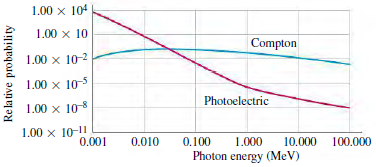The probability of a photon interacting with tissue via the photoelectric effect or the Compton effect depends
Question:
(a) Via the Compton effect only;
(b) Mostly via the photoelectric effect until they have lost most of their energy, and then mostly via the Compton effect;
(c) Mostly via the Compton effect until they have lost most of their energy, and then mostly via the photoelectric effect;
(d) Via the Compton effect and the photoelectric effect equally.
Figure P38.44

Malignant tumors are commonly treated with targeted x-ray radiation therapy. To generate these medical x rays, a linear accelerator directs a highenergy beam of electrons toward a metal target€”typically tungsten. As they near the tungsten nuclei, the electrons are deflected and accelerated, emitting high-energy photons via bremsstrahlung. The resulting x rays are collimated into a beam that is directed at the tumor. The photons can deposit energy in the tumor through Compton and photoelectric interactions. A typical tumor has 108 cells/cm3, and in a full treatment, 4-MeV photons may produce a dose of 70 Gy in 35 fractional exposures on different days. The gray (Gy) is a measure of the absorbed energy dose of radiation per unit mass of tissue: 1 Gy = 1 J/kg.
Step by Step Answer:

University Physics with Modern Physics
ISBN: 978-0133977981
14th edition
Authors: Hugh D. Young, Roger A. Freedman





